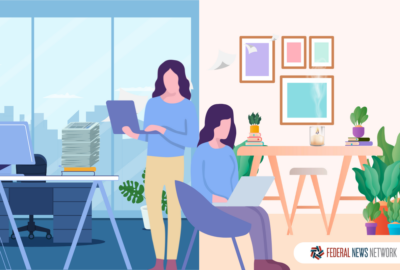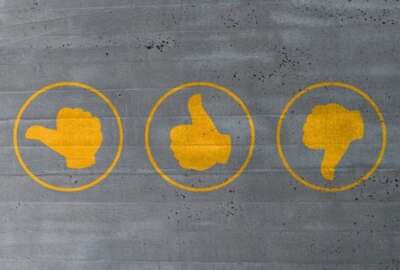Exclusive
Survey: Back in the office, feds feel mixed on office space functionality
As agencies aim to improve in-person collaboration, Federal News Network’s survey of 6,300 feds finds many don’t think return-to-office layouts are up to par.
Editor’s Note: This story builds on initial analysis of Federal News Network’s April 2024 return-to-office survey of federal employees. The story includes results for several of the survey’s questions, but not all of them.
As agencies send their employees back to the office more regularly, some feds are showing up to work only to find a sea of near-empty cubicles waiting for them.
Despite an administrative push for more collaboration and “meaningful” work in the office, employees said in reality, many federal offices have limited or no physical spaces to effectively host team meetings or events.
“It is cubicle city,” wrote one respondent to Federal News Network’s recent survey of more than 6,300 current federal employees.
When it came to physical office space, the return-to-office survey’s results were split into nearly equal thirds. Employees’ responses had close to even numbers for those who found office space either sufficient, insufficient or somewhere in between.
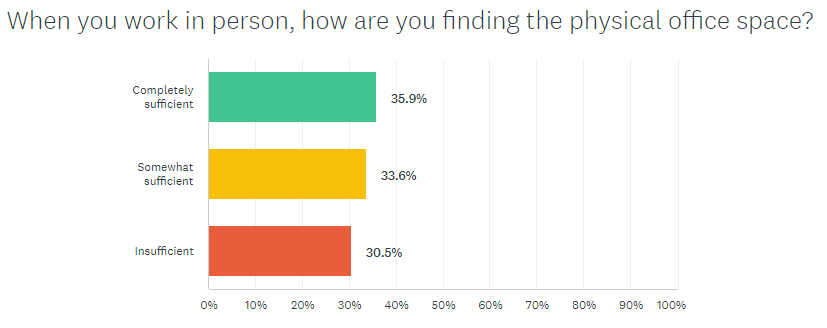
With more employees coming into the office more often, some survey respondents said it’s been challenging to find the right type of space to work — or to have enough space in the first place. Others said their office arrangements aren’t adapted to or reflective of the changing needs of working in person.
“We don’t have great meeting spaces,” one survey respondent wrote. “I tried to meet with a coworker on my floor last week and we couldn’t connect to a larger screen because there were none provided. We had to work side by side on our laptops.”
Those with cubicle-style work arrangements in older federal buildings said the setup is distracting, especially for those who have now spent years getting accustomed to work-from-home arrangements. While working in cubicles, employees said they can often hear others’ conversations or calls — and that leads to lower productivity.
“It’s very distracting having to hear every program’s meeting — not to mention, when someone comes to work sick, it’s nerve-wracking,” one respondent wrote.
Another survey respondent wrote, “The new desk arrangements are uncomfortable and not helping me stay relaxed and focused at work. [There are] smaller cubicles [and] half walls, arranged so our backs are to everyone else.”
Some respondents expressed a desire for agencies’ office space setups to better align with the administrative goals of working in person. They said agencies should put more emphasis on collaborative, co-working spaces, rather than siloing off employees to complete individual work.
“I mostly wish that our offices had more team space, conference space [and] workshop space. That’s what we need,” one respondent wrote. “We don’t need butts in seats, we need space for engagement. That’s the only useful aspect of our offices.”
Balancing space with design after return-to-office
The return-to-office survey findings contrast with agencies’ efforts to create “core collaboration days,” which align employees’ in-office schedules so they’re working in person on the same days of the week. In the survey, results were relatively neutral on the impacts of those collaborative efforts.
Employees’ concerns over the functionality of office space come at the same time that agencies are struggling to reduce their physical footprint. A recent report from the Public Buildings Reform Board found that agencies have more office space than the federal workforce needs, and the cost of maintaining that space continues to rise.
But at the same time, the board said while selling or disposing of real estate they don’t need, agencies have a unique opportunity to reinvest their budgets in office spaces with modern amenities, which could improve staff morale.
The General Services Administration’s guiding principles for federal office space recognize that there’s still a need for office space, but that its purpose is shifting. Now, the focus is on making space for collaboration and connections amid a largely hybrid federal workforce.
GSA has been trying to address the functionality of office space through the creation of its Workplace Innovation Lab (WIL). Federal employees and teams can reserve space in the D.C.-area co-working space, which uses comfortable furniture, innovative conferencing layouts and technology that’s better primed for employee collaboration.

Some of the WIL’s workspaces, for example, include reconfigured cubicles intended for small team meetings rather than individual work.
Chuck Hardy, the chief architect at GSA, told Federal News Network in February that on the whole, agencies should ensure their workspaces are agile and flexible enough to address the current work environment, while also readying that space for possible changes in the future.
Resources, food options in and around the office
Beyond office space alone, employees said some resources are limited both in and near the office. For instance, in the return-to-office survey, feds said there aren’t enough affordable, healthy lunch options around some federal buildings. For some, federal cafeterias and vending machines leave much to be desired.
After returning to the office more often, more than half of survey respondents said food options were “insufficient.”
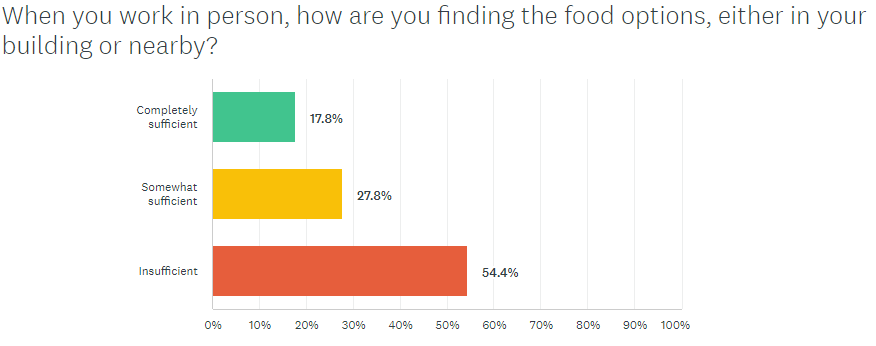
“The cafeteria is too expensive, and the food is less than adequate,” one survey respondent wrote. “The distance to grab food takes the majority of my lunch time. I’m unable to drive somewhere due to the lack of time — the distance to walk to my car and drive to the location and back.”
Other survey respondents said there were no food options nearby, period.
“Our office cafeteria has closed,” one respondent wrote. “To eat lunch, I must bring it from home or walk over a mile each way.”
Another respondent wrote, “food options within the building are non-existent. A large modern cafeteria has been shuttered for four years.”
By comparison, close to 80% survey respondents are finding the availability of office equipment, such as chairs and desks, as well as computers and other in-office technology, either somewhat or completely sufficient.

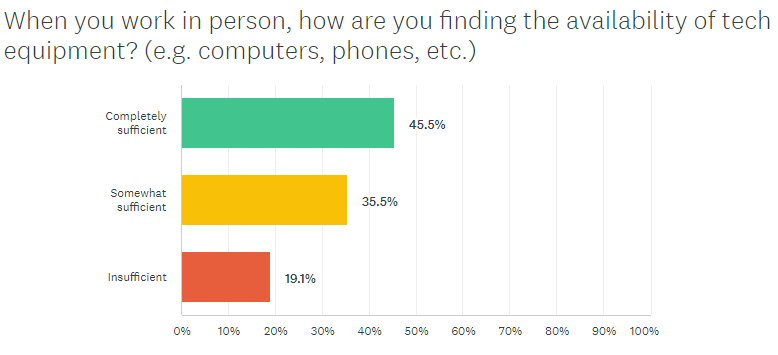
Some survey respondents, however, still raised concerns about shared spaces, as well as the use of hoteling, or desk-sharing. A couple respondents pointed out that if too many employees are present on a certain day, not everyone will be able to get their own desk.
In large part, the availability of space depends on the agency and the specific office building.
For example, one survey respondent wrote that “hoteling space is sufficient, though remote meetings are problematic and conference rooms are not where they need to be for successful hybrid meetings.”
But another respondent wrote that “hoteling space is very limited. Equipment at the hotel spaces is hit or miss. Some are pretty old.”
Still, some employees said regardless of the availability of resources or collaborative spaces in the office, they didn’t feel a desire or a need to report to work in person. Like the results of many return-to-office surveys, a majority of respondents said they are more productive while teleworking.
One respondent wrote, “There is nothing the office can provide me by way of equipment or amenities that are enticement enough to justify the commute or cost of commuting, when compared to the comforts provided by home.”
Copyright © 2025 Federal News Network. All rights reserved. This website is not intended for users located within the European Economic Area.
Drew Friedman is a workforce, pay and benefits reporter for Federal News Network.
Follow @dfriedmanWFED




